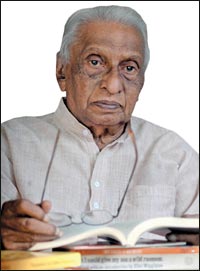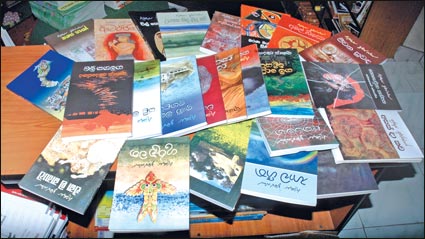|
Gunadasa Amarasekara:
Musings on an incomplete journey
Sachitra Mahendra
|

Gunadasa Amarasekara.
Pictures by Saman Sri Wedage
|
He is profoundly at home with both folk and classical poetry. He
would recite verses in Selalihini Sandesa and Guttila by heart. Yet his
profession is poles apart, being a dental surgeon.
Dr. Gunadasa Amarasekara marks his position in Sinhala literature
more as a poet, though he started off writing short stories and went
ahead with the novel. He accelerated the Sinhala poetry syringing his
influence from the folk tradition.
Although he belongs to a bilingual generation Amarasekara has not
written a single creative work in English.
“You should write to your immediate audience. So to say, you have to
write in the indigenous language.”
English authors
What is wrong with writing in English, then? Amarasekara questions
about the audience of Sri Lankan English authors. Writing in English
indicates a certain psychological condition: inferiority complex. Some
local English novelists do not seem to have read classical literature at
all, Amarasekara opines.
“If we are to write a creative piece in English, then it should have
a universal appeal, shouldn’t it? I don’t think our Sri Lankan English
literature has a universal appeal. In fact I have never seen our English
publications in European markets.”
If Sinhala literature stagnates, Amarasekara goes on to say, Sri
Lankan English literature should be a worse case then. Most of the
Sinhalese writers are at least familiar with the local pulse beat.
English writers have to take up the challenge of making the reader
familiar with the local environment. It will nevertheless sound foreign
as well as alienated.
Language shift
Our modern generation is full of monolinguals, owing to the official
language shift in 1956. This has more disadvantages than advantages. The
Sinhala writer’s literary scope has become confined.
“Great writers like Martin Wickramasinghe and Ediriweera
Sarathchandra were bilinguals. They read quite a lot of English works,
and they had an unlimited access to a wide literature.”
Wide literature! Since English became the international language,
nearly every masterpiece has been translated into English. You enjoy all
world renowned masterpieces, only if you have a good command in English.
But that doesn’t mean you can write in English with equal nuances.
“Remember all great artistes such as Boris Pasternak wrote in their
indigenous languages. They talked to the hearts of the immediate
audience. You cannot arouse same pathos with a second language.”
Fluent English
Professor Ediriweera Sarachchandra was fluent in many languages
including English. But he could not get the same imagination power in
his works translated into English by himself. Reggie Siriwardana notes
Sarachchandra’s creative English is so weak.
“I may have my personal conflicts with Sarachchandra. But he is a
genius in his Sinhala creative works, no doubt. Sarachchandra was well
received in the local audience, because he wrote in the common man’s
language.”
We require English to get influence, not to imitate.
Classical literature
“I fervently believe in our ancient Sinhala literature. But our
horizons widen, when we study beyond our own literature. We start
comparing the literatures.
We become familiar with the classical literature, ultimately.
Danger of being a monolingual is to entertain half baked western
concepts. Many mug up translations, misunderstand and start imitating
western concepts such as post modernism.
His village Yatalamatta, in which he was born in 1929, is present in
many of his creative works. He always touches the fondness of coming
back to the roots. Sometimes it is sensitive.
Sometimes it is harsh. All his works, be it a novel, short story,
poetry or literary criticism, reflect that more or less.
He headed the new Peradeniya school of poets in the 1950s, when he
completely turned down the idea of foreign influence.
He had clashes with Ediriweera Sarathchandra and Siri Gunasinghe who
dwelled on the Western influence.
“I had the access to English literature. But our Sinhala folk poetry
amused and amazed me a lot. I was sort of drowned in their poetic
spirit.” Amarasekara recollects his memories, softly.
Pseudo intellectuals
|

Some of Gunadasa Amarasekara’s books |
He is always tough on the pseudo western educated intellectuals, who
look down on our cultures. All his creative works, in that sense,
reflect a sort of disillusionment.
“I felt this disillusionment for the first time, when I left for
England. I saw how our people try to get along with the Whites, and I
felt how futile it was. The Whites seemed to be happy the idea that we
are a poor nation.”
The Whites must have laughed at secrecy seeing us trying get along
with their customs; we being their one-time colonies, after all.
This made Amarasekara go back to roots, in a stern sense.
His publisher, Gevindu Kumaratunga, takes every effort to bring out
all the publications in an eye-catching form. Gevindu has the rare luck
of being a grandson of legendary Sinhala writer Kumaratunga Munidasa.
“Gevindu is a perfectionist. He wants everything perfectly done. I
think that’s why I find proof errors very rarely.”
 Gunadasa
Amarasekara is a rare species who can write beautiful classical Sinhala
generating sensitive imagination. Gunadasa
Amarasekara is a rare species who can write beautiful classical Sinhala
generating sensitive imagination.
Yet the very same man is harsh about the way the modern novel is
headed.
Ancient classics
“Our novel deteriorates so fast. This is because our novelists
neither read ancient classics nor western classics. They just touch an
elephant blindfolded, and come out with good for nothing works.
I am looking forward to seeing an era when our creative writers
manipulate the ancient classics and be influenced by the western
classics.”
When that dream will come true, we can only wonder.
An excerpt from short story Disonchinahami
How pleased his professor would be to read this report on
Disonchinahamy; Kumar could predict that he would write back immediately
asking for all the details of the case.
How rearely did one encounter the kind of tumour found on
Disonchinahamy; Kumar remembered his professor mentioning that in all of
medical literature there were only three accurate reports of this
particular tumour which had long been a matter of serious controversy.
If so, would not this be the fourth such accurate report? Yet, in
preparing the report, who should he approach the matter? This was the
big question, the major problem facing him from the moment he sat down
to write his report.
Should he consider it a ‘giant cell granuloma’ a giant cell tumour or
a giant cell sarcoma? Was this a situation that contradicted the theory
that giant cell tumours only occurred in long bones and not in jaw
bones? It was not necessary to come to nay final decision on this.
Nobody expected that.
But how good it would be if one could treat it in the report as a
giant cell tumour, which all the available evidence seemed to indicate
it was.
Translated by Ranjini Obeysekere
... forte in poetry
In his ‘Enabling Traditions’ Professor Wimal Dissanayaka gives a
strap line to his essay on Gunadasa Amarasekara: Poetry, Tradition and
Social Truth.
That sums up Gunadasa Amarasekara’s forte. He entered the poetry
stream with his collection Bhava Geetha in 1955. With all spirits of a
youth, he attempted to remodel the poetry.
He believed the poetry should touch the modern issues.
Poets such as Ananda Rajakaruna, Sri Chandraratne Manawasinghe and G.
H. Perera used the poetry to address modern issues too, but they were
often confined to the traditional metre. Amarasekara got on to seek a
modified metre.
He was influenced by Kumaratunga Munidasa’s Piya Samara for the first
time. Uyanaka Hinda Liyu Kavi bears testimony for Amarasekara’s
influence.
Amarasekara was always fond of the sound quality of the poetry. He
did not believe much in free verse, which doesn’t give out the sound
beauty.
He was largely influenced by works such as Sihaba Asna and Dalada
Siritha in arousing sound in the poetry.
If his Amal Biso touches the folk feature of the poetry, a later
collection Gurulu Vatha denotes more emphasis on classical myth. With
Amal Biso Amarasekara gives the lie to the opinion that the folk poetry
is restricted in its pathos.
Amarasekara always found solace in poetry. It was nowhere but the
language of heart for him. In fiction Amarasekara doesn’t reach the
aesthetic climax which he could handle with such mastery in poetry.
... in fiction
His first short story Soma won much accolades in 1952. It was
translated into English in the US later on. He takes a revolutionary
step in 1955 with Karumakkarayo. This novel reflects a rarely touched
social trait: a woman having relationship of incest with her brothers
and indicatively with father. When he wrote Yali Upannemi, he was put to
censure from many quarters – likes of Ven. Henpitagedara Gnanasiha and
Martin Wickramasinghe – save Ediriweera Sarathchandra who admired and
recommended the work to be introduced into other languages. Amarasekara
followed D. H. Lawrence, Andre Gide and the Japanese erotic style mainly
in authoring Yali Upannemi. He accepted the criticism, hence no reprint
is available since the 60s.
Following this episode, Amarasekara’s novels took a new shape. He
initiated a self-referential middle class journey with eight novels:
1. Gamanaka Mula
2. Gam Dorin Eliyata
3. Inimage Ihalata
4. Vanka Giriyaka
5. Yali Maga Vetha
6. Duru Rataka
Dukata Kiriyaka
7. Gamanaka Meda
8. Ataramanga
(launched recently at the Colombo International Book Fair)
These novels portray Amarasekara’s political philosophy. He foresaw a
youth insurrection early in the 1960s.
Amarasekara was looking forward to seeing a younger generation who
can stand alone without the state support.
But that youth resurrection did not turn out positive as he thought
it would be.
Amarasekara’s literary contributions
Novelist
Karumakkarayo
Yali Upannemi
Depa Noladdo
Gandhabba Apadanaya
Asatya Kathavak
Premaye Satya Kathava
Gamanaka Mula
Gam Doren Eliyata
Ini Mage Ihalata
Vankagiriyaka
Yali Maga Vetha
Duru Rataka Dukata
Kiriyaka
Gamanaka Meda
Short Story writer
Ratu Rosa Mala
Jeevana Suvanda
Ekama Kathava
Ektemen Polovata
Katha Pahak
Gal Pilimaya saha Bol
Pilimaya
Marana Manchakaye
Dutu Sihinaya
Pilima Lovai Piyevi Lovai
Vil Thera Maranaya
Poet
Bhava Geetha
Uyanaka Hinda Liyoo
Kavi
Amal Biso
Gurulu Vatha
Avarjana
Asak Da Kava
Polemicist
Abuddassa Yugayak
Anagarika Dharmapala
Marxvadida?
Ganaduru Mediyama
Dakinemi Arunalu
Arunaluseren
Arunodayata
Jathika Chinthanayai
Jathika Arthikayai
Sinhala Kavya
Sampradaya
Samaja Deshapalana
Vichara I
Samaja Deshapalana
Vichara II
Nosevuna Kedapatha:
Navakathave
Parihaniya |



